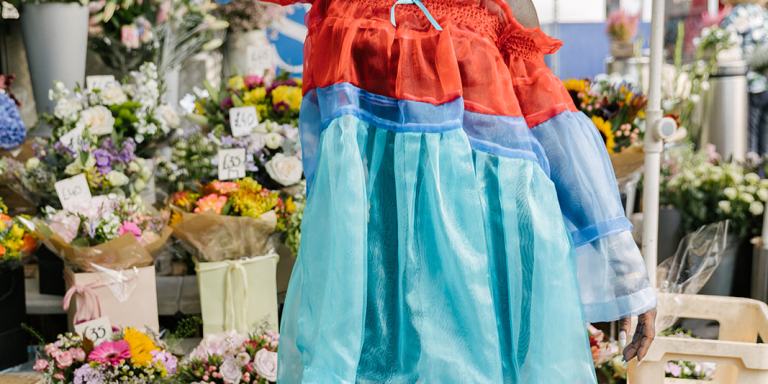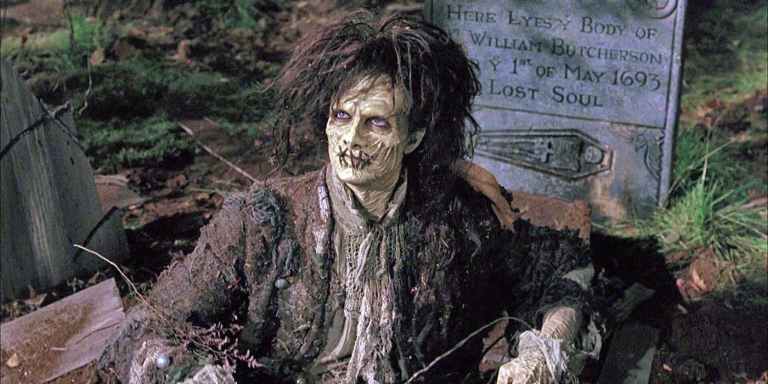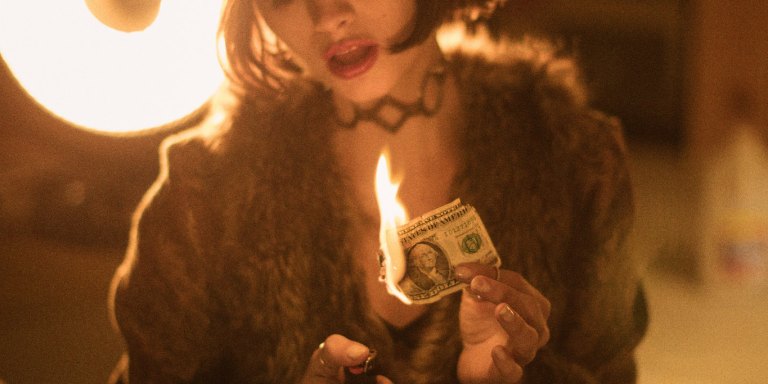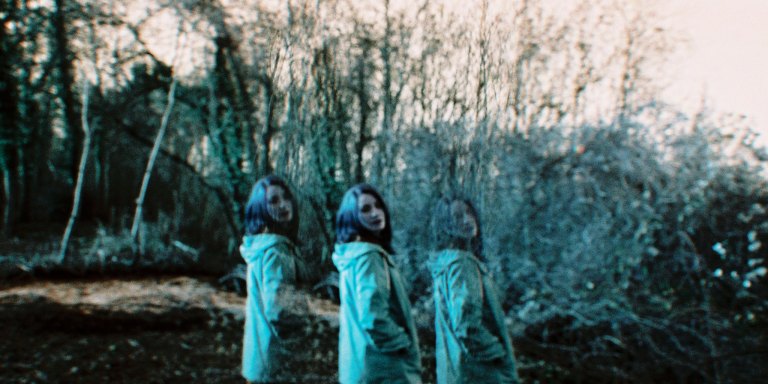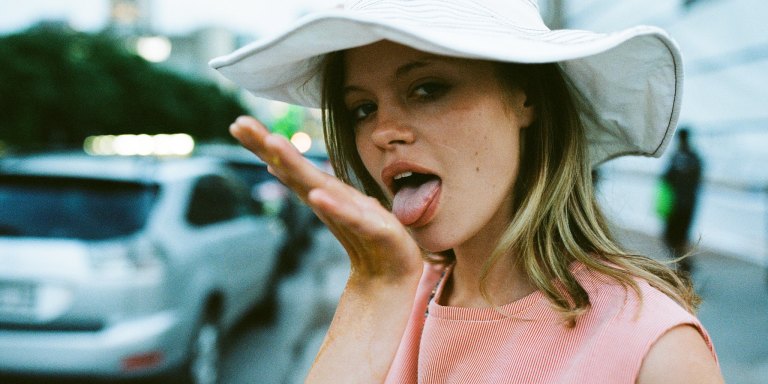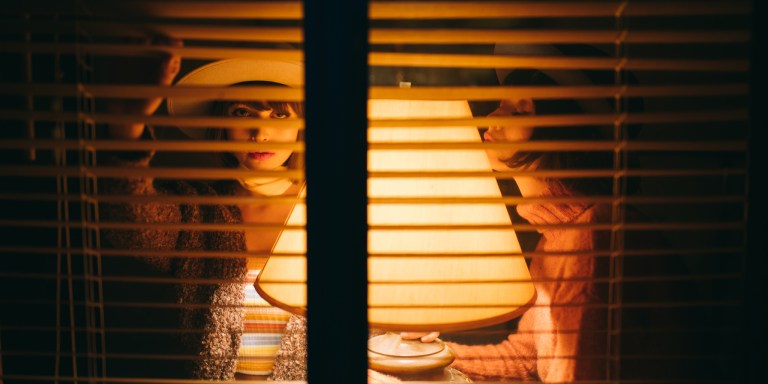If you want to sleep soundly tonight, you might not want to read about these mythological creatures discussed on Ask Reddit.
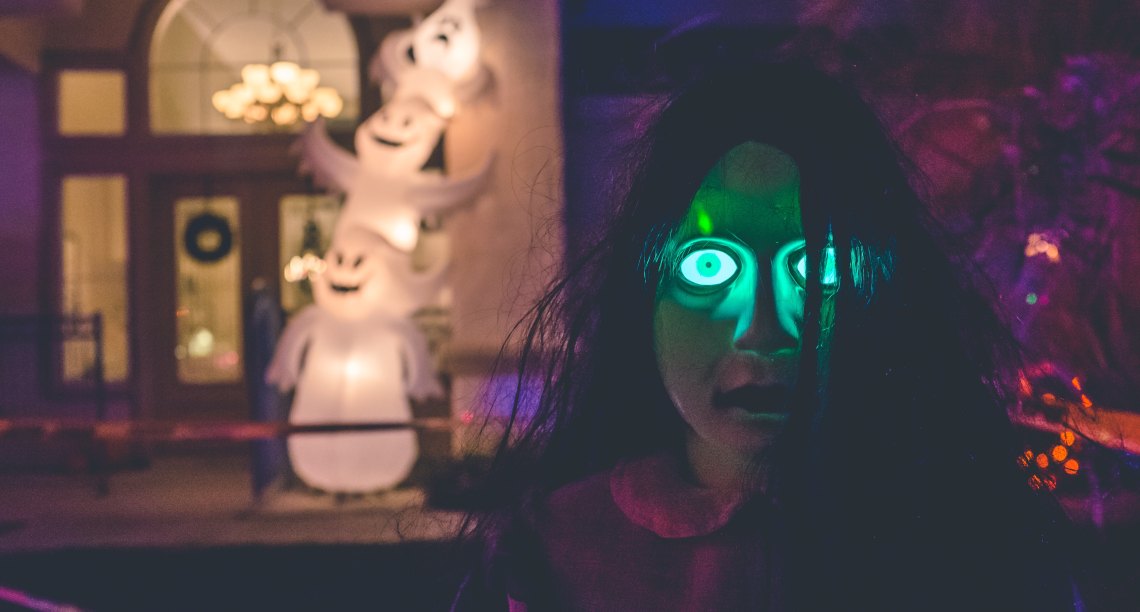
NeONBRAND
1. The Slit-Mouthed Woman
“There’s Kuchisake-onna, (the Slit-Mouthed Woman). A beautiful woman wearing one of those cloth masks, roaming the streets at night.
She’d ask children ‘Am I pretty?’ and if they answered yes, she removed her mask and asked again. If the kid answers yes or screams, she cuts them to resemble herself. If they answers no, she walks away, then murders them in their bed that night.” — EnkoNeko
2. The Dullahan
“The Irish (Original Sleepy Hollow). The Dullahan /duːˈləhɑːˌn/ is a headless rider, usually on a black horse who carries his or her own head under one arm. Usually, the Dullahan is male, but there are some female versions. The mouth is usually in a hideous grin that touches both sides of the head. Its eyes are constantly moving about and can see across the countryside even during the darkest nights. The flesh of the head is said to have the color and consistency of moldy cheese. The Dullahan uses the spine of a human corpse for a whip, and its wagon is adorned with funeral objects (e.g., candles in skulls to light the way, the spokes of the wheels are made from thigh bones, the wagon’s covering made from a worm-chewed pall or dried human skin). When the Dullahan stops riding, that is where a person is due to die. The Dullahan calls out the person’s name, at which point the person immediately perishes.
There is no way to bar the road against a Dullahan—all locks and gates open to them when they approach. They do not appreciate being watched while on their errands, throwing a basin of blood on those who dare to do so (often a mark that they are among the next to die), or even lashing out the watchers’ eyes with their whips. They are frightened of gold, and even a single gold pin can drive a Dullahan away.” — CheGaffero
3. La Segua
“I’m gonna go national, La Segua, she’s a beautiful woman drunk men would encounter while riding home late at night on rural roads, she’d ask if she could hitch a ride on the back of their horse and if and when they turned back to look at her, perhaps to try and kiss her, they’d find sitting behind them the woman but with the rotting face of a horse skull.
She then presumably kills them or just scares the ever loving shit out of them – I love legends that very clearly arose from wives trying to scare their husbands into not straying when they went out drinking with da boys.” — Krov_Koshka
4. The Ghoul
“I’ve always had a dark fondness for the ghoul of Persian folklore; basically a shape shifting monster who lurks in wastelands and/or graveyards, with a fondness for dead human flesh. It can assume the guise of an animal, and lures you into abandoned places to slay and eat you. The ghoul then takes on your appearance, and returns to live your life, but in reality it drains and destroys those you loved.” — Nash_Rambler
5. The Kelpie
“The other Scottish loch monster.
Only two lochs in Scotland are reported to have monsters: Loch Ness and Loch Morar, but the Kelpies are a whole other thing. They appear usually as beautiful white horses and lure you in, then, they trap you and drag you below water to drown you.
They don’t fuck around, they drag you down into the depths and drown you.” — OhHiGCHQ
6. The Wendigo
“I like the Wendigo a lot. There are a handful of different versions, but they’re all cool.
First is the spirit of cannibalism. It’s like a possessing force that makes a person want to eat human flesh, found mostly in northern climates where getting stranded without food in the winter is a much more common possibility.
Second is a northern ghoul variant – a person who eats human flesh becomes a wendigo, rather than eating flesh because they were possessed by a wendigo. The creepiest version of this I’ve seen is a floating humanoid figure that moves quickly with the wind, with a starved figure and a distended belly because they’re always starving for more human flesh.
The third is more recent, linking descriptions of Bigfoot or yeti with the wendigo myth, where it’s something like a humanoid furry creature. I’m not too fond of this depiction; I find it less creepy if it’s some kind of non-human beast or demon.
The definitive non-Native depiction of the Wendigo is from Algernon Blackwood’s The Wendigo, which is a great story.” — steeldraco
7. Each Uisge
“Without question, the Each Uisge (pronounced something like ‘ak ishka’). In Scottish mythology it’s a shapeshifting horse that frolics around enticing riders to climb up and go on an adventure with it. These adventures typically lasted as long as it took the Each Uisge to get near a body of water, because then its skin would turn adhesive and it would drag the rider screaming to the bottom to be drowned and eaten. It can shapeshift into other things, but the ‘Scottish Murderhorse’ aspect is easily the most metal.” — Otopython
8. Pesta
“I’m gonna have to go with Pesta, an anthropomorphic personification of the Black Death from Norwegian folklore. Pesta was an old woman dressed in black, carrying with her a broom and a rake. She travelled from village to village, bringing pestulance and death with her. If you was carried the broom, she would take the lives of everyone at the farm. If she carried the rake, a few would survive.
There’s a lot of stories told about Pesta, one of which is about a ferryman.There was a ferryman out in his boat one evening. On his way across the water he could hear someone call out for him. He looked towards the harbor and there he could see a old woman. As he came closer to the harbor he could see it was not some ordinary woman, it was Pesta herself.
The ferryman called out with a trembling voice. ‘I will bring you across if you spare my life!’ The old crone slightly tilted her head and reached for the big black book she hid within her clothing. With a bony finger she read the names written within, her thin and pale lips muttering to herself.
She lifted her eyes towards the ferryman. Who now had reached the harbor, and said, ‘You do not escape, but you will die a peaceful death.’ The old crone stepped on board the boat and seated herself in the prow. When the ferryman came home later that evening, he felt very tired. So he laid himself down in bed, and never woke up.” — exteus
9. Doppelgänger
“The creepiest one in my opinion has always been the ‘Doppelgänger’ from Bavarian folklore, which is similar to the ‘Changeling’ from Irish folklore except it’s not related to fairies.
These days we use the word ‘doppelgänger’ to reference someone’s non-related twin. Someone who naturally looks exactly like someone else without any blood relation. It’s a rare coincidence, but that’s not the word’s original definition.
Traditionally the doppelgänger was seen as a sign of bad luck, but those sightings were likely caused by hallucinations since no one who truly believed in this phenomenon would spot themselves in public and not confront the other person unless the other person simply didn’t exist.
However, there are also superstitions which claim the doppelganger is a non-human entity which can alter its physical appearance to literally become someone else and take their place. It was said that the doppelgänger consumed the original person once the transformation was complete. This was used to explain early misunderstood cases of Alzheimers. It was also used as an answer to severe depression and violent thoughts that a mother might have towards her children since it was believed that no mother could ever hurt her own child unless she wasn’t truly the mother.
The thought of someone in your life being replaced by an entity which only pretends to know you and care about you is pretty creepy.” — KicksButtson
10. The Pukwudgie
“The Pukwudgie. An American criptid with a mythological history.
It’s said to exist in the forests starting in the east coast mountains and all through to Kentucky. Several Native American tribes describe these creatures. They resemble small men, around a foot tall with gaunt features. There most prominent attributes would have to be there unusually large noses and shaggy long moss colored hair.
The story goes that at one point the Pukwudgie tribes didn’t mind humans but when one was accidentally killed they went hostile. Now they hate people with a passion. They can blend in or become invisible to humans, they also can make basic weapons like poisoned darts designed to create pain. They use these abilities to torment people, or even kill as they revel in tricking humans to there deaths.” — Atlusfox
11. The Gumiho
“The Gumiho from Korean legends. They’re slightly different to the Kitsune, as the Gumiho are always evil that feast upon human flesh, while the Kitsune is more of a prankster type.
The Gumiho disguises as females to attract boys, and once they’re finally both in love, they feast on the boy’s organs and flesh.” — LanceCorporalDororo
12. Zombies
“Zombies. And to be specific, slow zombies. They endlessly creep towards you to eat your brains. Sure, they are slow. You can kill or evade one, maybe even a few, but they just relentlessly keep coming in ever greater numbers. You board up your doors and windows, but their dead hands reach through any gap. They keep pushing and trying. Relentlessly. All the while their desperate moans fill your ears driving your mind with fear to the brink of madness. Yes, hell has been filled due to the evil of man and the dead now walk the earth.” — Danmax
13. Azatoth
“Azatoth, from H.P Lovecraft’s cthulhu mythos.
Basically a mass of teeth, tentacles and milky blind eyes sitting in the center of reality, being soothed by his demonic chorus.
In the cthulhu mythos this thing is god, a blind, constantly dreaming entity, and our universe is but one of his many dreams. Also somehow this thing has descendants, one of which is the big C himself.
I just really find the idea of god instead of being a loving, kindhearted entity, he is instead an abomination that barely is even aware of our existence interesting. Also an interesting thing about Azathoth is Lovecraft didn’t really ever write a story detailing too much about Azathoth, he was going too, but he died before it could be completed, leaving only a partially started draft which honestly I think is much more interesting than having a full story, since it then leaves Azathoth where he belongs, beyond our understanding.” — warrior457
14. Nuckelavee
“Nuckelavee’s are pretty dang cool and also horribly terrifying. It’s the torso of a human fused to the torso of a horse. The horse has one eye and it breathes disease and has really long arms that reach the ground from where the human part is ‘sitting.’ It also has no skin and is considered to be the most evil creature in Orcadian mythology.” — McZerky
15. Mermaids
“Mermaids are so diverse. They can be beautiful echantresses waiting for your love and affection by the beach, or man eating sea monsters, luring weak men to their death with their appearance and voices.” — Shina-nya
16. The Minotaur
“The thought of being stuck in a labyrinth with a giant Bull man terrifies me and the fact that there is apparently an ACTUAL labyrinth (Of course there was no Minotaur) makes it all the more fascinating to me.” — Kingjaffad
17. The Banshee
“The banshee could be included I suppose but that myth is actually real, the real banshee was a real crying woman who would mourn over a dead person, on many occasions this crying was the first the family learned of their relatives death.” — IrishMicko
18. The Bunyip
“Generally the bunyip is supposed to look something like an alligator or crocodile, or maybe a large salamander or small hippo-like creature. It’s generally described as an aquatic ambush predator that jumps out at you from the water in Australia.” — steeldraco
19. The Penanggalan
“The penanggalan. Goddamn things are terrifying. Flying vampiric heads trailing their innards behind them as they float around at night.” — blinkyzero
20. Cthulhu
“It’s great and 99% of people who know about Cthulhu know the wrong thing about it.
They think its a big monster, that you can fight it, you can tame it, whatever.
It represents something so powerful that you just can’t comprehend it, trying to understand it drives you mad.
It’s more like how a person in a 2d world would have no idea what to make of us as a 3d person. We would just be these weird undulating shapes popping into and out of existence. Cthulhu represents the same thing, something so much bigger that we can’t know or even comprehend it’s real form.” — mysaltyalt
21. The Hecatoncheires
“The Hecatoncheires, they have one hundred hands and fifty heads. They seem almost beyond the limits of human imagination as we don’t really have common image of what one looked like.” — th3cr3a7or
22. Krampus
“Krampus was always a favorite of mine.
The original folklore stories surrounding Krampus are terrifying. Some giant goat hybrid monster that seeks out, steals, and eats children who misbehave.” — tendy_trux35
23. The Näcken
“The Näcken/nixie/neck/whatever.
There are different variations of it, but basically it’s a waterspirit that can either do terrible or good things to you. If you please it (and there are many different variations on what it considers pleasing) it can play beautiful music or teach you how to play beautiful music.
If you piss it off, one version is that it transforms into an ugly old man who dances naked And this sight is so horrifying it’s been known to drive men mad.” — Manaakii
